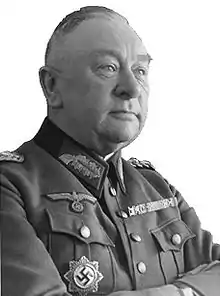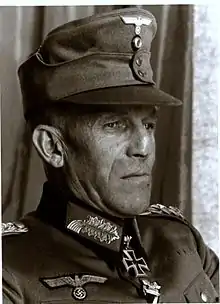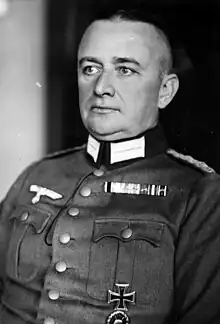| Army Group Rear Area Command | |
|---|---|
| Befehlshaber des rückwärtigen Heeresgebietes | |
| Active | 1941–45 |
| Country | |
| Branch | Army (Wehrmacht) |
| Part of | Army High Command (OKH) |
| Engagements | World War II |
| Commanders | |
| Notable commanders | Eduard Wagner |
Army Group Rear Area Command (German: Befehlshaber des rückwärtigen Heeresgebietes) was an area of military jurisdiction behind each of the three Wehrmacht army groups from 1941, the German invasion of the Soviet Union in Operation Barbarossa, through 1944 when the pre-war territories of the Soviet Union were recovered. The areas were sites of mass murder during the Holocaust and other crimes against humanity targeting the civilian population.
Background and planning
During the early stages of the planning for the invasion of the Soviet Union, Operation Barbarossa, the rear areas behind the front lines were envisioned to be subordinated to the respective armies, as they had during the invasion of Poland. By early April 1941, however, the military planners decided to limit the areas of army jurisdiction (Rear Army Area), with the bulk of the territory to be controlled by the Army Group Rear Areas.[1]
The planners envisioned that the occupied territories would quickly pass onto civilian administration; thus, the directives called for the Army Group Rear Areas commanders to concentrate on the security of lines of communication and important military installations, such as storage depots and aerodromes. Army Group Rear Areas were also responsible for the transfer of prisoners of war to the rear.[2]
Organisation
Army Group North, Army Group Centre and Army Group South Rear Area Commands were responsible for the rear area security in their respective areas of operation. Each had a headquarters subordinated to the corresponding army group, while also reporting to the Wehrmacht Quartermaster General Eduard Wagner, who had responsibility for rear security.[3] Each Army Group Rear Area had a propaganda company, for propaganda activities aimed at the civilian population.[4]
Army Group Rear Area commanders controlled nine Security Divisions, tasked with security of communications and supply lines, economic exploitation and combating irregular fighters (partisans) behind the front line. Security Divisions also oversaw units of the Geheime Feldpolizei (Secret Field Police) of the Wehrmacht. Rear Area commanders operated in parallel with the Higher SS and Police Leaders appointed by the head of the SS, Heinrich Himmler, for each of the army group rear areas.[3] In the words of historian Michael Parrish, these army commanders "presided over an empire of terror and brutality".[5]
Security warfare and atrocities
The area commanders' duties included security of communications and supply lines, economic exploitation and combating guerillas (partisans) in Wehrmacht's rear areas.[6] In addition to the Wehrmacht security forces, the SS and the SD formations operated in the same areas, under the command of the respective Higher SS and Police Leaders. These units included Einsatzgruppen detachments, three police regiments (North, Centre and South), the Waffen-SS units of the Kommandostab Reichsführer-SS, and additional Ordnungspolizei (Order Police Battalions), which units perpetrated mass murder during The Holocaust in the areas of military jurisdiction.[7]
The security formations, often in coordination with or under the leadership of the Wehrmacht, conducted security operations against the civilian population, under the doctrine of Partisanenkrieg (later Bandenbekämpfung, or "gang fighting"). "Anti-partisan operations" in "bandit-infested" areas amounted to destruction of villages, seizure of livestock, deporting of able-bodied population for slave labour to Germany and murder of those of non-working age.[8] In its reports, the Wehrmacht units euphemistically described the operations as "elimination of partisan nests, partisan camps, partisan bunkers". Their records show that in the early phases of the occupation, in 1941–42, Wehrmacht security divisions lost one soldier killed for every 100 "partisans" that died, with the Jewish population making up the majority of the victims.[9] In the Army Group Centre Rear Area, 80,000 "suspected partisans" were killed between June 1941 and May 1942, for 1,094 German casualties.[10]
Commanders
- Army Group North Rear Area
| No. | Portrait | Commander | Took office | Left office | Time in office | Ref. |
|---|---|---|---|---|---|---|
| 1 | General of the Infantry Franz von Roques (1887–1967) | 16 March 1941 | 1 April 1943 | 2 years, 16 days | [5] | |
| 2 | General of the Infantry Kuno-Hans von Both (1884–1955) | 1 April 1943 | 30 March 1944 | 364 days | [11] |
- Army Group Centre Rear Area
| No. | Portrait | Commander | Took office | Left office | Time in office | Ref. |
|---|---|---|---|---|---|---|
| 1 | General of the Infantry Max von Schenckendorff (1875–1943) | 16 March 1941 | 6 July 1943 † | 2 years, 16 days | [12] | |
| - | General der Gebirgstruppe Ludwig Kübler (1889–1947) Acting | 22 July 1943 | 1 October 1943 | 71 days | [11] | |
| 2 | General of the Cavalry Edwin Graf von Rothkirch und Trach (1888–1980) | 1 October 1943 | 1 July 1944 | 274 days | [11] |
- Army Group South Rear Area
| No. | Portrait | Commander | Took office | Left office | Time in office | Ref. |
|---|---|---|---|---|---|---|
| 1 | General of the Infantry Karl von Roques (1880–1949) | 15 March 1941 | 27 October 1941 | 7 months | [13] | |
| - | General of the Infantry Erich Friderici (1885–1967) Acting | 27 October 1941 | 9 January 1942 | 2 months | [5] | |
| (1) | General of the Infantry Karl von Roques (1880–1949) | 9 January 1942 | 31 December 1942 | 11 months | [13] | |
| 2 | General of the Infantry Erich Friderici (1885–1967) | 31 December 1942 | February 1943 | 1 month | [5] | |
| 3 | General of the Infantry Joachim Witthöft (1887–1966) as Army Group B Rear Area | February 1943 | 27 October 1943 | 8 months | [11] | |
| 4 | General of the Infantry Friedrich Mieth (1888–1944) as Army Group Don Rear Area | 27 October 1943 | 2 September 1944 | 10 months | [11] |
See also
References
Citations
- ↑ Hill 2005, pp. 40–41.
- ↑ Hill 2005, pp. 42–43.
- 1 2 Megargee 2007, p. 36.
- ↑ Hill 2005, p. 42.
- 1 2 3 4 Parrish 1996, p. 127.
- ↑ Shepherd 2003, p. 70.
- ↑ Brandon & Lower 2008, p. 276.
- ↑ Shepherd 2004, p. 63.
- ↑ Wette 2006, pp. 127−128.
- ↑ Wette 2006, p. 130.
- 1 2 3 4 5 Pohl 2008, p. 100.
- ↑ Beorn 2014, pp. 95–96.
- 1 2 Megargee 2007, p. 95.
Bibliography
- Brandon, Ray; Lower, Wendy (2008). The Shoah in Ukraine: History, Testimony, Memorialization. Indiana University Press. p. 12. ISBN 978-0-253-35084-8.
- Beorn, Waitman Wade (2014). Marching into Darkness: The Wehrmacht and the Holocaust in Belarus. Cambridge, Massachusetts: Harvard University Press. ISBN 978-0-674-72550-8.
- Hill, Alexander (2005). The War Behind The Eastern Front: The Soviet Partisan Movement In North-West Russia 1941–1944. London & New York, NY: Frank Cass. ISBN 978-0-7146-5711-0.
- Megargee, Geoffrey P. (2007). War of Annihilation: Combat and Genocide on the Eastern Front, 1941. Rowman & Littlefield. ISBN 978-0-7425-4482-6.
- Parrish, Michael (1996). The Lesser Terror: Soviet State Security, 1939–1953. Praeger Press. ISBN 978-0-275-95113-9.
- Pohl, Dieter (2008). Die Herrschaft der Wehrmacht: Deutsche Militärbesatzung und einheimische Bevölkerung in der Sowjetunion 1941–1944. Oldenbourg Wissenschaftsverlag. ISBN 978-3486580655.
- Shepherd, Ben H. (2003). "The Continuum of Brutality: Wehrmacht Security Divisions in Central Russia, 1942". German History. 21 (1): 49–81. doi:10.1191/0266355403gh274oa.
- Shepherd, Ben H. (2004). War in the Wild East the German Army and Soviet Partisans. Cambridge, Massachusetts: Harvard University Press. ISBN 0674043553.
- Wette, Wolfram (2006). The Wehrmacht: History, Myth, Reality. Cambridge, Massachusetts: Harvard University Press. ISBN 978-0-674-02577-6.




.jpg.webp)


